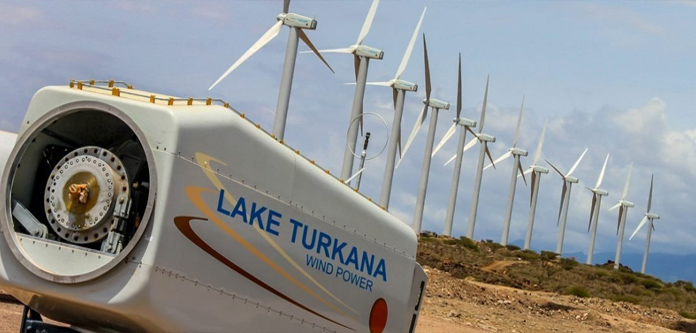Article Source. Mwonjoria, Muchemi ” State House Kenya – Kenya scores another first as President Kenyatta commissions Africa’s largest wind power project , 20, July . 2019,
State House Kenya – Kenya scores another first as President Kenyatta commissions Africa’s largest wind power project

Kenya is on track to fully level up green energy production by 2020. The recent launch of The Lake Turkana Wind Power project – the largest project of its kind in Africa, is a glaring example of Kenya’s potential in the energy sector.
The project is an impressive achievement, with 365 wind turbines operating with a capacity of 850 kilowatts each, increasing the country’s electricity supply by 13 per cent.
Along with being an important environmental achievement, Kenya’s expertise in the energy sector can transform its greatest domestic asset into a tool of global importance.
The plant is registered with the UN Framework Convention on Climate Change, and approved at the Gold Standard rating, with the transmission line able to carry three times the amount of power that will be produced by the existing plant, allowing for a smooth upgrade in the future.
Importantly, the project was funded by a consortium of African and European companies. Not only is the plant a serious upgrade for Kenya’s own electricity grid, but it will also earn the developers more than US$ 200 million in carbon credits over its lifetime.
Along with being good news for shareholders, it increases the attraction of Kenya’s green energy investment potential.
The profitability, stability and expertise now on show in Kenya is worth 10 times its weight in electrons.
Kenya is already a global leader in the geothermal sector and renewable projects like the Garissa Solar Power Station and the Ngong Wind Power Plant have showcased the country’s potential as a global green powerhouse for almost every form of renewable energy.
International powerhouse
As can be seen from Turkana, there is already significant international interest in investing in Kenya’s domestic market. Beyond building green power plants, millions of dollars are being invested in an ambitious umbrella plan aimed at connecting all homes to electricity by 2022.
The best part is that Kenyan innovation is at the heart of this move, with off-grid renewable energy companies pioneering in bringing services to cut-off areas.
Overall there are plenty of investment-ready projects raring to go, and now that financial supply far outweighs demand, it is time for Kenya to focus on becoming an international powerhouse – a green energy exporter to the world.
There will naturally be an increase in energy demand in the coming decades, both from the continent and further afield. In Africa, the advances in off-grid solutions will allow for whole new paradigms in access to electricity.
According to International Energy Agency, the worldwide energy demand is expected to grow by 27 per cent by 2040, or the equivalent of 3,743 million tonnes of oil. As the Paris Agreement takes effect and non-complying countries are put under increasing pressure, we can expect much of the demand to be in the form of renewable, not fossil fuels.
Energy exporter
Developing countries are on course to increase our combined global energy demand by 45 per cent, growing the share of global demand from 64 to 70 per cent.
Kenya’s neighbouring countries and countries across Africa have similar potential for green energy. However, they are certain to lack the economic opportunities afforded to Kenya to realise that potential.
Kenya’s impressive domestic situation and attractive investment outlook presents a unique and timely opportunity to become Africa’s predominant energy exporter.
“To press home our advantage, all we must do is continue, and even expand, the vision of the current policy; investing accordingly with established partners who see the potential inherent in our country.”
Kenya is not the only country in Africa harnessing this potential. Namibia recently announced its ambitious renewable energy strategy, which includes building four renewable energy plants to harness energy from biomass, solar and wind over the next five years.
Ethiopia and other countries have also developed some of their natural renewable resources. However, for many governments it will be difficult to replicate the investment potential inherent in the increasingly sunny Kenyan economy.
If Kenya can supply cheap, green electricity to the region and beyond, the ripple effect on the wider economy is incalculable.
Not to mention, Kenya will be achieving an even more important goal, sustainable development at a time where all of our futures depend on a green power revolution.
LOGIN / REGISTER
![]()
Stay Connected












